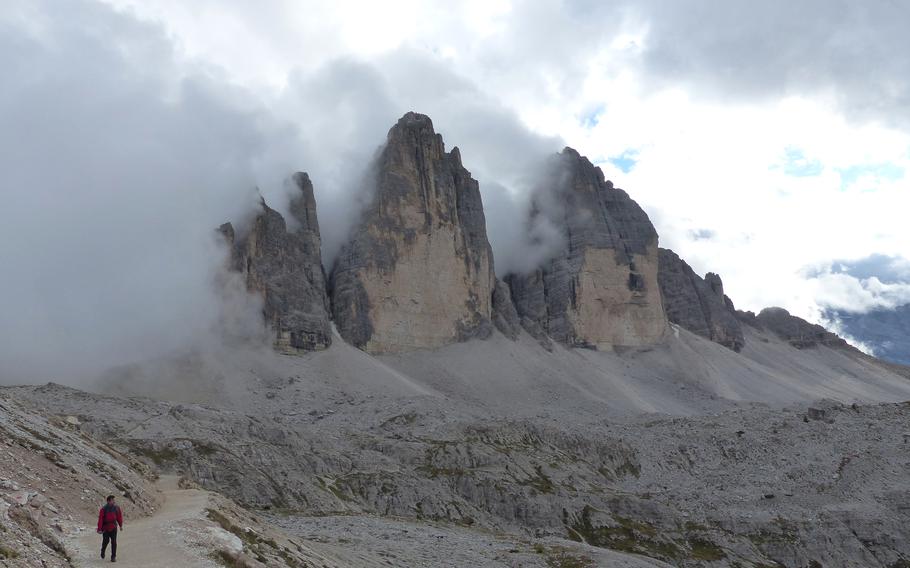
Fog rolls in toward Tre Cime di Lavaredo, Italy’s famous three peaks. In contrast to Italy’s historic metropolises of Rome and Florence, the mountainous northern region of Trentino, South Tyrol feels like another planet. (Elizabeth Landau/For The Washington Post)
My first encounter with Italy's famous "three peaks" - the Tre Cime di Lavaredo - was in a traffic circle. In the picturesque town of Dobbiaco/Toblach, three small painted sculptures in the center of the roundabout marked the gateway to one of the most iconic views in the Italian Alps. At a nearby cafe, my partner's chocolate schnitzel came with a powdered sugar cutout of the peaks, akin to an Eiffel Tower-themed dessert near Paris. "It's the Cime!" I exclaimed. We were on our way.
Above the village, in the jagged Dolomite mountains, rustic huts linked exclusively by footpaths offer food, drink and beds along countless miles of trails, with views of wonder at every turn. This is not what Americans generally imagine when they think of Italy. In contrast to the historic metropolises of Rome and Florence, the mountainous northern region of Trentino, South Tyrol feels like another planet. But for a few days of our European getaway last year, my partner and I wanted to get lost in natural vistas rather than touristy plazas.
Tour companies abound, but I love planning itineraries and allowing time for spontaneous excursions. So I did a lot of research to find hiking routes that promised spectacular views and included huts, but didn't require a car to access an entry trail. And we had to time it right, because most huts open from part of June through September. We considered several options, but photos of the Tre Cime Natural Park made me stop and wonder: "Wait, how do mountains get to look like that?"
For a night's rest before the journey, I booked Hotel Dolomiten in Dobbiaco, also known as Toblach, for mid-September. Dobbiaco is located on a rail line to Fortezza, which has train connections to major cities with airports. (We chose Munich.) For our hike, we'd catch a bus from Dobbiaco. I made two hut-room reservations by email ahead of time, and left a third night open to the whims of the mountains.
Bus 444 from Dobbiaco took us on a beautiful drive past sparkling Lake Dobbiaco and up to Rifugio Auronzo in less than an hour. Considering the view, it felt like cheating; we hadn't even left the parking lot, and I wanted to take a thousand photos of the mountains and valley below. But we had miles of hiking ahead of us, and for the next few days, our feet would be our only form of transit.
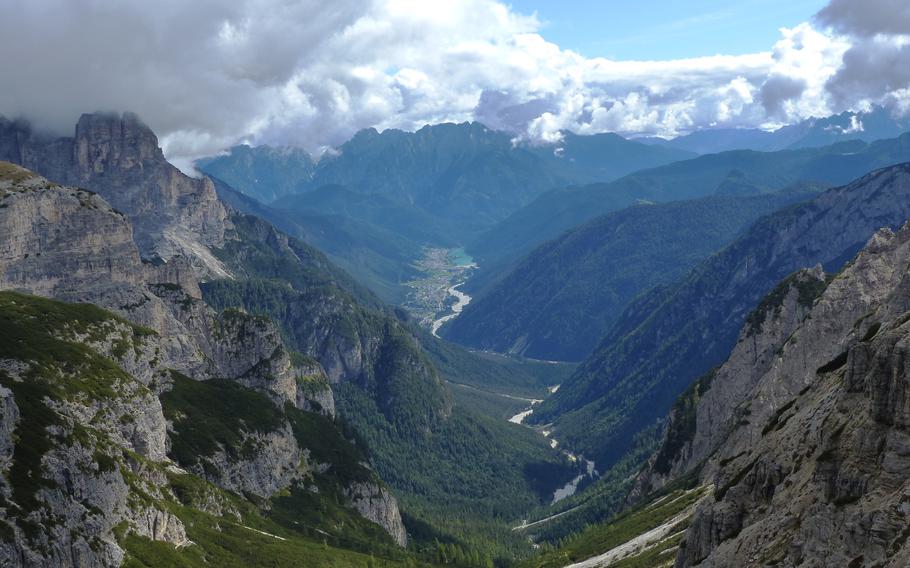
A short walk from the Rifugio Auronzo bus stop is this view of a valley-and the views from the bus rides are impressive as well. (Elizabeth Landau/For The Washington Post)
From the bus stop, it was an easy 20-minute walk to Rifugio Lavaredo, where we would spend our first night. Impressively, when we checked in, the staff knew our dietary requirements - nut allergy for me, vegan for my partner - when they presented us with dinner options for later. We dropped our overnight packs in the private room and headed into the sunny afternoon.
The huts, the valleys, the towns, the mountains themselves - everything carries both German and Italian names, the result of a complicated and painful history. Before World War I, the South Tyrol region had been part of the Austro-Hungarian Empire. The glory of the mountains obscures the brutality of war - and winter conditions - that killed many soldiers by the same mountain passes hikers now traverse.
In 1920, Italy formally annexed South Tyrol, and over the next several years, waves of new regulations made the Italian language mandatory at the government level, then in schools. In 1939, thanks to a collaboration between Mussolini and Hitler, German speakers had to either assimilate as Italian or leave for Germany. After World War II, South Tyrol became a generally peaceful multilingual region, with an additional minority Romance language called Ladin. But there are a lot of remnants of war in this region, such as tunnels and trenches.
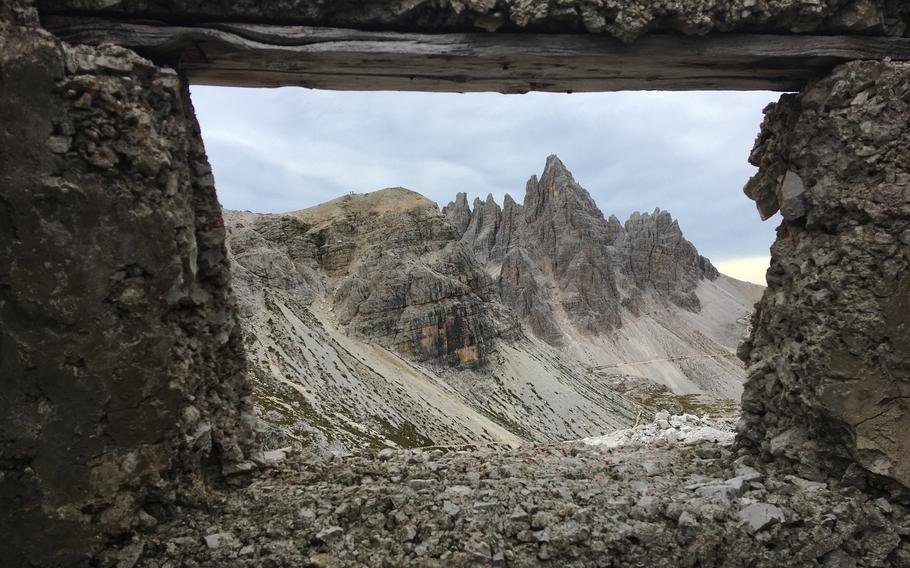
Remnants of conflicts abound in the Dolomite mountains; this view is from the ruins of a lookout possibly used during World War I. (Elizabeth Landau/For The Washington Post)
Our first hike was to the north faces of the Tre Cime. Closest to us was the smallest peak, Cima Piccola, which looks a bit like a fist with a thumb and half a forefinger sticking up. In the middle, the biggest one is - unsurprisingly - Cima Grande, rising more than 9,800 feet above sea level. And on the right was Cima Ovest, the western peak. We scrambled over rocks to the base of Cima Piccola for a breathtaking panoramic view. Each of the Dolomites' natural skyscrapers was pointy or sloping in its own way. The Lavaredo hut we'd left looked like a toy house below us. In the distance, the red-roofed Rifugio A. Locatelli, called Dreizinnenhütte in German, seemed like a mirage among the gigantic peaks and striking slopes around it. "You know, the Cime aren't even the most impressive mountains here! They're just the most famous," my partner said.
It was an easy walk - maybe another half-hour - along the trail to Locatelli, which has two levels of porches overlooking the Tre Cime and other seemingly impossible rocky peaks and slopes. By now, the weather had changed, with a thick fog covering the Cime and delivering a drizzle as we enjoyed beers on the porch. Rain drenched us as we headed back, and the shortcut hill to Rifugio Lavaredo looked especially perilous. I nearly panicked and longed for the hiking sticks I had decided not to purchase, because airports don't allow them in carry-on bags. Instead, as my partner and I carefully shuffled down the slippery slope, I improvised a silly jingle: "Hütte! Do the little hütte descent!" With patience and a sunny tune, we arrived safely.
That night at Lavaredo, we learned mountain hut customs: Shoes must be replaced with slippers, communal showers cost 5 euros, meals are taken at an assigned time, lights go out around 10 p.m., there's no WiFi and no credit cards are accepted. And after 18 months of pandemic isolation in our home of Washington, D.C., meeting fellow travelers felt both strange and refreshing; it had been so achingly long since I had struck up a conversation with a stranger or traded travel tips.
On Day 2, we layered up for a just-above-freezing September day, but with the bright sun and rigorous trail, we quickly stripped down to shirts. From above the clouds, we hiked Trail 104 into a valley where cowbells echoed in an incredible cowbell concert that seemed to crescendo each time one of the cows mooed. "More cowbell!" I yelled. A man in traditional lederhosen shorts and suspenders passed us and took a downward fork, perhaps for business with the cows below. My thighs were burning by the time we had completed all of the ups and downs of this path, but the cowbell chorus was worth the hours of effort.
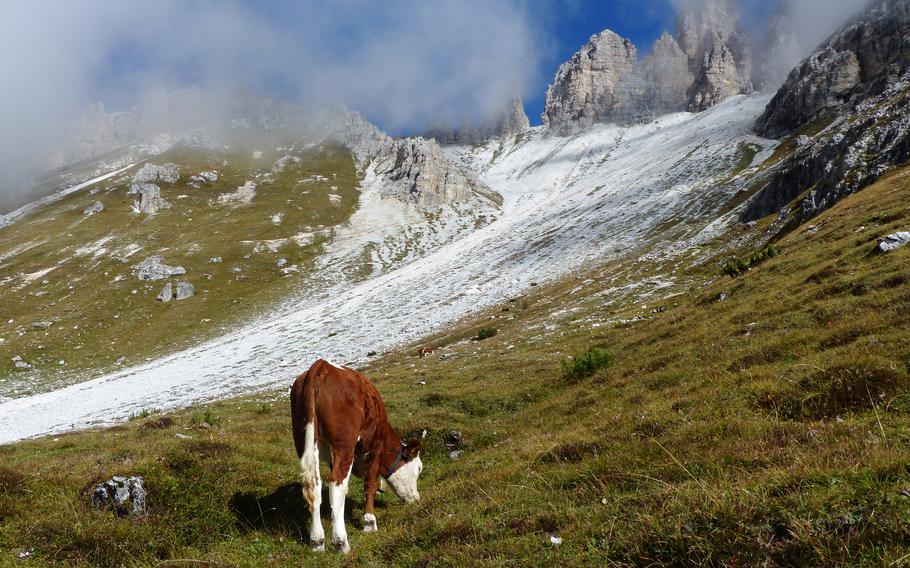
A cow grazes in Tre Cime Natural Park. Cowbells echo through the valleys, prompting a shout of “more cowbell!” from a hiker. (Elizabeth Landau/For The Washington Post)
After a final strenuous ascent and a last flat jaunt, we arrived at the bustling Rifugio Pian di Cengia/Büllelejochhütte patio, where two musicians performed American folk hits in slight German accents. My partner and I jubilantly sang along to "Blowin' in the Wind" and chatted with a couple of locals who come to this restaurant once a week. Here I discovered my favorite mountain meal: kaiserschmarrn, a shredded pancake with caramelized sugar, powdered sugar and lingonberry preserves. We took the advice of the locals and hiked to a nearby dramatic overlook, which we had all to ourselves.
Finding Trail 101 toward our next hut, we came upon a sign informing us of a World War I "secured war trail." Curious, we detoured to find a cave where soldiers might have lived - both a sobering monument and a fantastic photo opportunity for the jagged crest of Cima Undici. Outside the cave, the top of the rocky tower beckoned. We climbed precariously steep steps and held on to the attached steel cables to ascend. I found myself panting and shaken from how far we'd climbed in a matter of minutes, but the views calmed me. In the distance, snow-covered peaks were on the horizon, and toward the northeast was Rifugio Comici/Zsigmondyhütte, which would be our home for that night. Because we didn't bring climbing gear for a more ambitious route, we returned to the hiking trail.
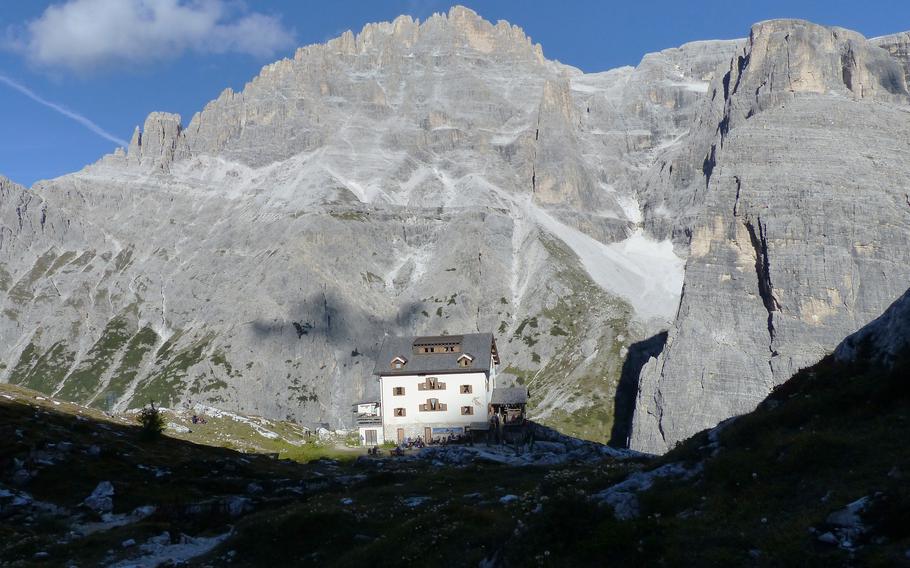
Rifugio Comici, called Zsigmondyhütte in German, with the Cima Undici mountain in the background. Many of the sites in the area have both Italian and German names. (Elizabeth Landau/For The Washington Post)
Comici offers a broad menu of local delicacies. I chose cheese dumplings with cabbage - plump like two giant matzoh balls infused with cheese, hearty and filling, like a food hug after a full day of hiking. My partner loved his vegan mushroom polenta, too. Unlike at Lavaredo, hikers seemed to keep to themselves, and the after-dinner vibe was "map time," where guests took out their maps and planned their hikes for the next day. Our private room consisted of a bunk-bed set, but we found the mattress more comfortable than at Lavaredo, and we savored the romantic mountain view from the window.
Having now seen many highlights of the park, we decided to make the long trek back to Locatelli to see whether there were beds for our last mountain night. It was a risk; the website boasts "an estimated 10,000 email inquiries per year." But if we got turned down, we'd return to our previous hotel in Dobbiaco, which we nicknamed "the Pizza Hütte" for its pizzeria, whose smell drifts through the hallways.
We found the Locatelli patio crowded, though fellow travelers said this was nothing compared with pre-pandemic times, when the area was "like Times Square." I was glad to see the Tre Cime again, too. At 3 p.m., a young woman with a clipboard told me we could stay in a dormitory room that will have up to 10 people, but all 10 might not show up. Because of the coronavirus, I was reluctant, but she assured me that they spaced out the bunk beds, so only every other set was occupied. I left the final decision to my partner, who just said, "This seems like more fun than a hotel."
I put aside my anxieties as we chatted with German travelers on a more elaborate two-week expedition. When we were mostly done with dinner, I noticed the bright yellow and orange colors of the sunset out the window, and I somewhat abruptly interrupted myself to go and look. Soon, everyone ran outside to ripples of gold, pink and purple in the sky, like a carpet extending toward a rocky peak formation that my partner dubbed "Red Panda Mountain" for its layers of reddish rock. (It's called Croda Rossa.) "We live in a postcard!" I exclaimed.
When the electricity went off for the night, I whispered to my partner that we should check the rest of the floor for empty beds. Lo and behold, an entire section of the attic dormitory room - with a dozen beds - was vacant, allaying my covid concerns. Unfortunately, the mandatory "sleeping bag liners" we'd purchased for 8 euros (about $8.50) each were like glorified paper towels, and the blankets that apparently don't get washed were very thin. I put on every piece of clothing I'd brought, and that still wasn't enough warmth. We took spare blankets off other beds, but it was a difficult, frigid night.
Nonetheless, there is no better sunrise than at Rifugio Locatelli. The lack of sleep was worth the morning light coloring mountain tips a bright salmon pink. The Tre Cime doesn't get the magical dawn sunbathing in late September, but we could see light creeping down Croda Rossa and other slopes from the dorm window.
After breakfast, we took a leisurely 2.5-hour hike to the bus stop, first descending below the Tre Cime, then upward and around the westernmost face, with plenty of pauses for photos. By now, the Tre Cime peaks had become old friends, though still otherworldly. In fact, I later learned that in the Star Wars movie "Solo," the perilous train heist on planet Vandor got its backdrop from this area.
As much time as we spent admiring these striking landscapes, I felt as if I still hadn't gotten enough. On the way down, at a bus stop in Misurina, a fellow hut traveler pointed to the Tre Cime in the distance when the bus doors opened. "Now you can say goodbye forever!" he said with a grin.
It made me sad. The mountains had more trails to travel, caves to explore, huts to sleep in. I didn't even finish my song! Hopefully, it wasn't really forever.
IF YOU GO
Where to stay
Hotel Dolomiten
Via Alemagna 3, Dobbiaco, Bolzano
011-39-0474-972136
A three-star hotel with beautiful town views and excellent pizza restaurant. Convenient to train and bus stations. Rooms from about $95 per person, per night.
Rifugio Lavaredo
Auronzo di Cadore, Belluno
011-39-349-602-8675
rifugiolavaredo.com/english.html
Mountain hut with restaurant near the Auronzo bus stop and a short hike from the Tre Cime di Lavaredo peaks. Open June 15 to Sept. 26. Cash only. Half board in shared room about $75 per person, per night; half board in private room about $80 per person, per night; children under 12 about $64 per person, per night.
Rifugio Comici (Zsigmondyhütte)
Sesto, Bolzano
011-39-0474-710358
Mountain hut with restaurant accessible on foot from Sesto or from the Tre Cime de Lavaredo trails. Opens mid-June. Accepts credit cards. Half board in private room for two about $84 per person, per night; half board in shared room about $78 per person, per night.
Rifugio A. Locatelli (Dreizinnenhütte)
Sesto, Bolzano
011-39-329-6690335
Mountain hut with restaurant and outdoor decks facing the Tre Cime di Lavaredo peaks. Cash only. Bring own linens or buy a "sleeping bag liner" for about $8.50. Beds in shared dormitory about $34 per person, per night; beds in smaller rooms about $50 per person, per night.
Where to eat
Rifugio Pian di Cengia (Büllelejochhütte)
Auronzo di Cadore, Belluno
011-39-337-451-517
Traditional foods from South Tyrol available to guests and a la carte. Cash only. Opens June 11.
Information: italia.it/en